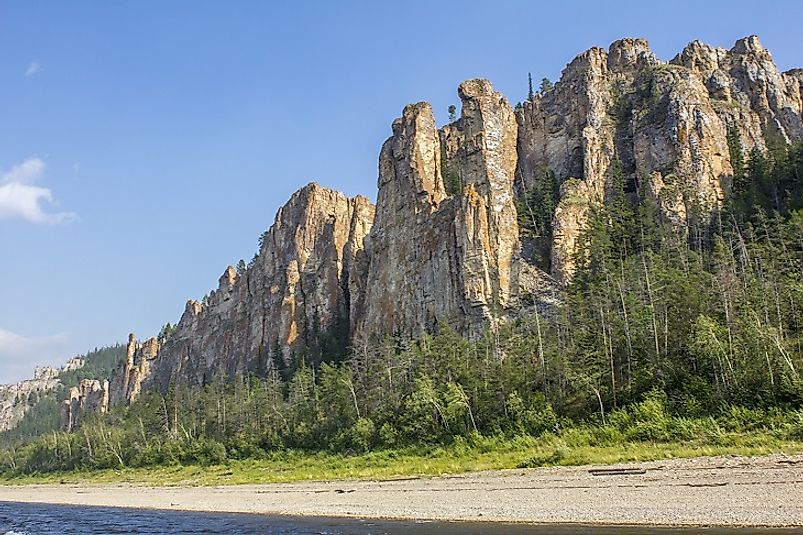The Lena River

5. Description
The Lena River is the 11th longest river in the world, flowing through a distance of 4,400 kilometers from its source in the Baikal Mountains 7 kilometers west of Lake Baikal, to its drainage point into the Arctic Laptev Sea. The drainage basin of the river covers a massive area of 2,490,000 square kilometers. The Lena River Delta is the largest Arctic Delta in the world, with an area of 32,000 square kilometers. Vast tracts of land along the river are protected in the form of nature reserves, such as the Lena Delta Nature Reserve, the Lena Pillars, and the Ust-Lensky Nature Reserve.
4. Historical Role
The origin of the name of the Lena River is said to have been derived from the local word Elyu-Ene, meaning the ‘Large River’. The river was probably first explored by a troupe of Russian fur hunters led by Demid Pyanda in the 17th Century. In 1623, Pyanda explored a 2,4000-kilometer stretch of the river. Since then, a large number of explorers have ventured out onto the Lena in order to record its course and discover its potential. In 1885, an expedition funded by the Russian Imperial Academy of Sciences, and headed by Baron Eduard von Toll and Alexander von Bunge, was carried out to explore the Lena Delta and its path of entry into the Arctic Ocean. Ever since the discovery of the river, the Lena has been used as a significant trade and transport route for cargo into the Arctic Ocean.
3. Modern Significance
The Lena River plays a very significant role in the life of the people settled along its banks. Where the river flows through lowland regions, a wide variety of crops, like cucumbers, potatoes, wheat, and barley, are commercially cultivated. Animal ranching is also widely practiced here, facilitated by the availability of vast pasture lands for animal grazing. The land around the Lena River also has a rich repository of mineral wealth, including such precious metals as gold and diamonds, as well as iron ores and deposits of coking coal, which are the two key ingredients in steel-making. Other coal and natural gas deposits also occur in this region. The Lena River is also largely navigable, allowing for the transport of cargo, including excavated minerals, fur, food, and industrial products, from their respective production areas to the consumption and trade centers along the banks and the rest of the world by way of the Arctic Ocean routes. The river also holds an immense potential for development of hydroelectric power, but only a small fraction of this prospect has been exploited to date.
2. Habitat
The varying temperature, topography, and precipitation patterns along the Lena River determines the vegetation of the region along its course. The central valley of the Lena River has wide expanses of steppe grasslands, while the floodplains of the river are characterized by typical taiga coniferous forests, along with peat bogs and swamps. Namely, Alder, willow, and birches grown in this region. Further north, in the river’s lower course, typical tundra types of vegetation prevail, with mosses, lichens, Arctic poppies, and Whitlow grasses covering the land surface in most areas. A large number of birds, including migratory species, nest in these habitats. Birds usually migrate to this land after the annual departure seen every winter to breed in the fertile wetlands of the region. Birds of prey, swans, geese, snipers, plovers, and sandpipers are among the birds commonly spotted near the Lena River Basin. Arctic lampreys, Arctic Cisco, other Cisco species, sturgeon, and Chung salmon are some of the commercially and ecologically important fish species of the Lena River. The river abounds in life, with 38 fish species and 92 planktonic species found therein.
1. Threats and Disputes
Not only is the Lena River still one of the cleanest sources of freshwater on this planet, but it also flows along its natural course, as its flow has not been impeded by the large-scale construction of dams and reservoirs. This sets the Lena apart from many other rivers that have been exploited for their respective high hydroelectric power-generating potentials. Threats from oil spills, however, do occur, as a large number of vessels carrying cargo ply on this river regularly. In fact, 25,000 tons of oil from the Lena River pollute the Arctic Ocean each year. Even though large areas of the river basin are protected, threats from overfishing, overgrazing, deforestation of land for cultivation, and excessive water extraction for irrigation of croplands continue to be ongoing problems.











